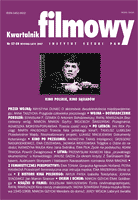"Coniunctio oppositorum". O celu wędrówki wgłąb "Trzeciej części nocy"
'Coniunctio oppositorum'. On the Goal of Journey into the Depth of 'The Third Part of the Night'
Author(s): Agnieszka MorstinSubject(s): Theatre, Dance, Performing Arts
Published by: Instytut Sztuki Polskiej Akademii Nauk
Keywords: Żuławski Andrzej
Summary/Abstract: This essay is a chapter in the doctoral thesis 'Wizerunki polskiej religijności w filmie fabularnym' ['Images of Polish Religiosity in Feature Film'] by Agnieszka Morstin-Popławska. She undertakes an attempt to interpret Andrzej Żuławski’s film as a text of culture that actualizes the myth of apocalypse: the myth is dealt with as a continually renewed model story clarifying the sense of events taking place in the story. The image of a disaster come true is interpreted as one of the crisis of the canon of culture; its destruction – according to the apocalyptic message – is however supposed to lead towards a revival of the world of values. The protagonist, who shows traces of ancient and Christian descent, embarks on the mission. The depiction of the hero’s journey through the night-enveloped world of war destruction is subordinated to the logic of (Victor Turner’s) liminal experience. According to Morstin-Popławska’s line of reasoning, the successive phases of this experience take place on the plane of a spiral labyrinth, the form organizing the space of the represented world. In addition to this interpretation of the labyrinthine-apocalyptic vision, the film fits the tradition of baroque with its concepts of a world and God in motion.
Journal: Kwartalnik Filmowy
- Issue Year: 2007
- Issue No: 57-58
- Page Range: 73-90
- Page Count: 18
- Language: Polish

